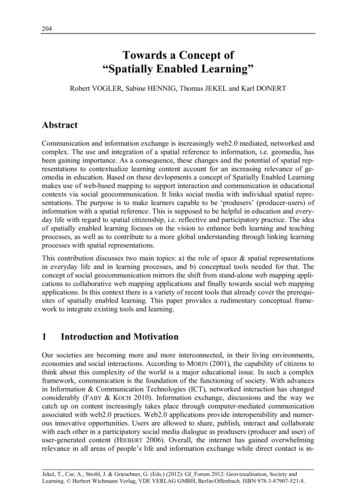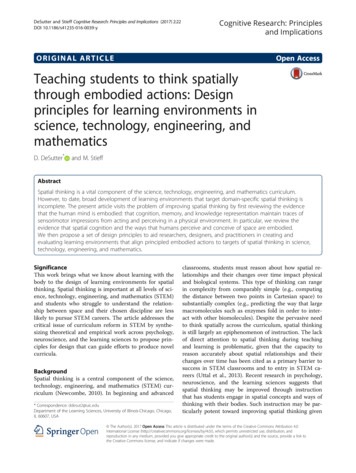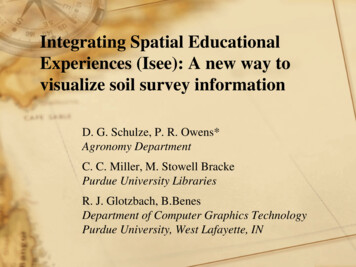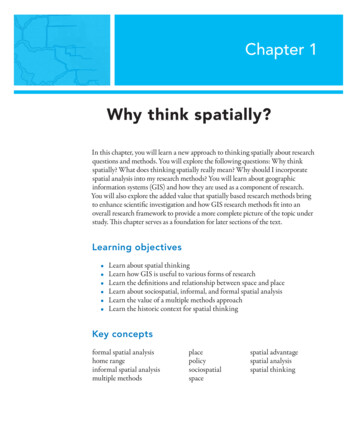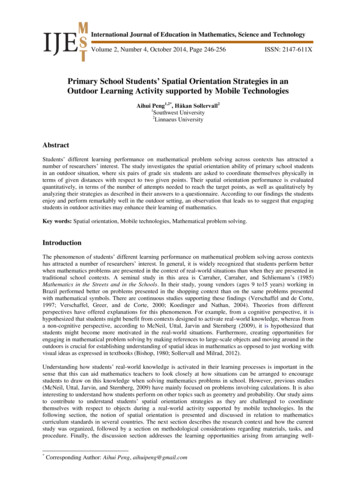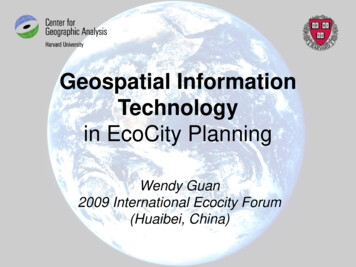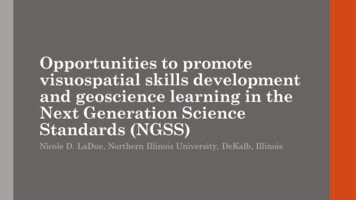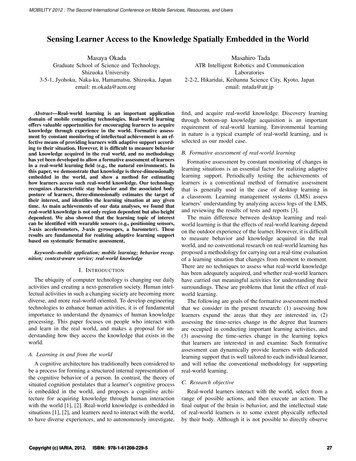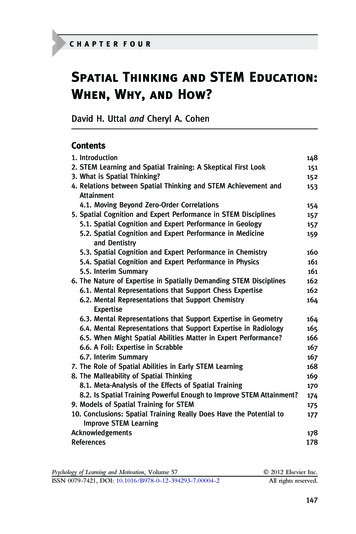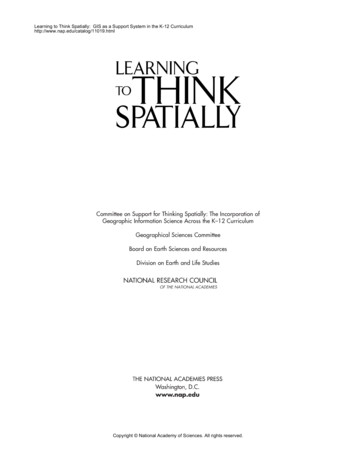
Transcription
Learning to Think Spatially: GIS as a Support System in the K-12 RNINGTHINKTOSPATIALLYCommittee on Support for Thinking Spatially: The Incorporation ofGeographic Information Science Across the K–12 CurriculumGeographical Sciences CommitteeBoard on Earth Sciences and ResourcesDivision on Earth and Life StudiesCopyright National Academy of Sciences. All rights reserved.
Learning to Think Spatially: GIS as a Support System in the K-12 e Nature of Spatial Thinking2.1 INTRODUCTIONIn Chapter 1, the committee defines spatial thinking as a constructive amalgam of three elements: concepts of space, tools of representation, and processes of reasoning. Space provides theconceptual and analytical framework within which data can be integrated, related, and structuredinto a whole. Representations—either internal and cognitive or external and graphic, linguistic,physical, and so forth—provide the forms within which structured information can be stored,analyzed, comprehended, and communicated to others. Reasoning processes provide the means ofmanipulating, interpreting, and explaining the structured information.In this chapter, the committee describes and explains spatial thinking in more detail. It beginsin Section 2.2 by looking at the current understanding of spatial thinking, distinguishing it fromnarrower concepts such as spatial ability, and viewing it as a means of problem solving. Section 2.3explores the use of space as a framework for understanding, identifying the three contexts in whichspatial thinking operates and pointing to the key role of spatialization. Section 2.4 turns to the threefunctions of spatial thinking: description, analysis, and inference. The basis for spatial thinking isthe structure of space and the operations that can be performed on and in that structure. Section 2.5builds a four-part structure of space based on primitives, languages of space, spatial concepts, andoperations. The chapter ends in Section 2.6 with a psychological analysis of the cognitive processesunderlying spatial thinking.2.2 APPROACHES TO SPATIAL THINKING2.2.1 Forms of Thinking About SpaceIn terms of its power and pervasiveness, spatial thinking is on a par with, although perhaps notyet as well recognized and certainly not as well formalized as, mathematical or verbal thinking. Itcan be contrasted with verbal thinking. Language allows us to express the output of direct sensoryperceptions of the world; it allows us to develop metaphors; and it can support abstractions such as25Copyright National Academy of Sciences. All rights reserved.
Learning to Think Spatially: GIS as a Support System in the K-12 EARNING TO THINK SPATIALLYmeanings that are counterfactual or hypothetical, or do not rely on direct sense perceptions. Anotherquality of verbal thinking is that it can be and most often is public and external. After millennia oftalking and writing, there are well-established, formal conventions of meaning and pragmatics thatensure considerable consensus across people within a language community. We have a goodunderstanding of what it means to be articulate and literate in the verbal domain. We can assessperformance in spoken and written forms, and we focus on the teaching and learning of verbalthinking.By contrast, there is as yet no clear consensus about spatial thinking and, therefore, spatialliteracy. Thus, there are many related concepts in use: we speak about spatial ability, spatialreasoning, spatial cognition, spatial concepts, spatial intelligence, environmental cognition, cognitive mapping, and mental maps (see for example, Eliot, 1987; Gardner, 1983; Golledge and Stimson,1997; Gould and White, 1974; Kitchin, 1994; Kitchin and Freundschuh, 2000; Newcombe andHuttenlocher, 2000; Portugali, 1996; Tversky, 2000a,b).Perhaps the most familiar of these terms is spatial ability. Spatial ability is conceptualized as atrait that a person has and as a way of characterizing a person’s ability to perform mentally suchoperations as rotation, perspective change, and so forth. The concept derives in part from thepsychometric tradition of intelligence measurement and testing with, for example, the French(French et al., 1963) reference test kit identifying types of spatial ability such as spatial orientationand visualization. By classifying the cognitive processes used to solve tasks thought to measurespatial ability, Linn and Petersen (1986) identified three categories of spatial ability: spatial perception, mental rotation, and spatial visualization. For example, spatial visualization is measured bytests such as the paper folding test (in which respondents are presented with drawings of foldedpieces of paper that have hole(s) punched in them and are asked to select which drawing indicateshow the paper would look when unfolded), and the embedded figures test (in which respondents areasked to find a simple shape within a complex one) (see Figure 2.1). Spatial ability has been studiedin terms of group and individual performance differences (see Eliot, 1987; Golledge et al., 1983;Linn and Petersen, 1985).Spatial ability is clearly related to but much more restricted in its scope than spatial thinking, asare all of the competing concepts. It is the links among space, representation, and reasoning thatgive the process of spatial thinking its power, versatility, and applicability. Spatial thinking ismultifaceted in its operation: just as there is no single recipe for how to think verbally or mathematically, there is no single way to think spatially. Instead, the process of spatial thinking comprisesbroad sets of interconnected competencies that can be taught and learned.FIGURE 2.1 Spatial visualization items. Left, embedded figures: respondents are asked to find the simpleshape shown on the top in the complex shape shown on the bottom. Right, paper folding: respondents areasked to indicate how the paper would look when folded. SOURCE: Linn and Petersen, 1985. Reprinted withpermission of the Society for Research in Child Development.Copyright National Academy of Sciences. All rights reserved.
Learning to Think Spatially: GIS as a Support System in the K-12 Curriculumhttp://www.nap.edu/catalog/11019.htmlTHE NATURE OF SPATIAL THINKING27At one level, we can learn to read the pressure and temperature axes of a phase diagram inphysics, to understand the relations between elements in the atomic chart in chemistry, to recognizethe particular shapes and locations that are indicative of tumors in an MRI, to understand the spatialproperties that are preserved by a modified Mercator projection in cartography, and to visualize thethree-dimensional spatial relations between different air masses and the associated types of frontsin meteorology. In each case, we can identify a particular set of spatial concepts that must be knownand understood and the interpretive skills, parts of spatial ways of thinking and acting, that must bemastered. Taken together, the set of concepts and skills forms a cognitive spatial tool kit that istuned to the practice of a particular discipline (for example, see Chapter 3.6.1). The tool kit mixesdomain-specific spatial knowledge (concepts, models, and theories) with the use of generic representational forms and spatial structures (e.g., Cartesian coordinate systems, linear and nonlinearrelations, scale transformations, rotations and perspective change). To the extent that there are toolsand technologies to be learned (e.g., how to take an MRI reading or to create a map projection usinga computer algorithm), we learn the spatial capabilities that make us proficient in a domain ofknowledge.At another level, as we become spatially literate, we develop a general spatial attitude. Thisentails a willingness and ability to frame problems in spatial terms, to use the language of space toexpress the elements of a problem, to think about relations between objects in terms of distances ordirections or patterns, to imagine alternative graphical representations, to change viewing perspective or viewing angle, to zoom in or out, to hypothesize and visualize the effects of different ratesof change, to predict what might happen to spatial patterns or structures or relations if . . . Bylinking spatial knowledge, spatial ways of thinking and acting, and spatial capabilities with thisgeneral spatial attitude, we have a flexible and powerful way of thinking that is transferable to andapplicable in a wide range of contexts in everyday life, the workplace, and science.2.2.2 Spatial Thinking as Problem SolvingOur concept of spatial thinking is broader than spatial ability and related concepts in that itapproaches the process of problem solving via the coordinated use of space, representation, andreasoning. Scientists in general and educators in particular have not paid sufficient attention toidentifying and articulating the nature, characteristics, and operation of what is arguably a definingcharacteristic of the scientific approach.Spatial thinking uses representations to help us remember, understand, reason, and communicate about the properties of and relations between objects represented in space, whether or not thoseobjects themselves are inherently spatial. Objects can be concrete things (as in a cognitive map ofroads and neighborhoods in a city) or abstract concepts (as in a two-dimensional graphic plot froma multidimensional scaling model of the love-hate relationships between characters in a Shakespeareplay). In the first case, there is an objective geographic space within which the objects exist andfrom which, on the basis of experience, we can calculate distances and directions. The subjectivecognitive map is a mental representation that may transform and systematically distort objectivedistances and directions between places. In the second case, the number and types of words exchanged between characters are converted into similarity measures and then distances betweencharacters. The graphic plot locates characters in a space in which one dimension is hate and theother love. Location in space can be used to understand the relationships between characters.Representations can be internal, a mental image of the workings of a pulley system, or external,a printed cross section of a geological structure or an immersive virtual reality display of theinterior of a new building. The forms of representation can range from a schematic diagram of apulley system to a photograph or movie of actual pulleys, lines, and weights. The cross-sectionaldiagram can be two dimensional, showing depth and extent, or a pseudo-perspectival diagramCopyright National Academy of Sciences. All rights reserved.
Learning to Think Spatially: GIS as a Support System in the K-12 EARNING TO THINK SPATIALLYshowing depth and two horizontal dimensions. It could be a geological cross section in which timereplaces depth as the vertical axis. Instead of an immersive space, the representation of the buildingcould be a plan and elevation, an architect’s three-dimensional physical model, or an ordered seriesof architectural renderings, viewing the interior from different places in the building with a nearphotographic appearance. Representations can capture what is (e.g., a map of a city), what might be(e.g., a sketch of an addition to a house on a lunchroom napkin), and what should be (e.g., a scorefor a piece of music or dance).Reasoning processes can ask: What happens if we add weight to one part of the pulley system,if we remove weight from another part, or if the string breaks in a particular place? We can askwhich parts move, how far, and what the equilibrium position is. In the other cases, we can ask howthe thickness of the rock layers varies with depth, or what the “sense” of space is that we “feel” aswe move through the lobby of the building. The questions can capture either the results of changeor the process of change. They can deal with possible or hypothetical (“what would it look like if”)situations (e.g., a fly’s-eye view of the atrium of the building or David Macaulay’s images of partsof the urban infrastructure “floating” in three-dimensional space without the surrounding andsupporting physical ground) (Figure 2.2).Spatial thinking occurs in private and in public. On the one hand, spatial thinking encompassesa range of cognitive processes that support exploration and discovery: we can visualize relations,imagine transformations from one scale to another, rotate an object to look at its other sides, createnovel viewing angles or perspectives, evoke images of places and spaces, and so forth (see Hansonand Hanson, 1993). On the other hand, spatial thinking allows us to externalize these operations bycreating spatial representations in a range of media, forms, and sensory modalities: tactile maps orgraphs, auditory maps, vibrotactile surfaces, traditional cartographic maps, two-dimensional graphs,link or flow diagrams, tree diagrams of hierarchical relations, three-dimensional (3-D) scale models, exploded views of a structure, and so on. The representations can be created as part of apersonal working dialogue. They can be shared with others, thus exposing the representational andreasoning processes of spatial thinking to public scrutiny. The representations are simultaneouslyways of expressing personal understanding and rhetorical acts of communication and persuasionthat can establish a public consensus.2.3 THE USE OF SPACE AS A FRAMEWORK FOR UNDERSTANDING2.3.1 Spaces for Interpreting DataCrucial to the power of spatial thinking is our ability to use space as a framework for understanding. The process of interpretation begins with data:Data consists of numbers, text, or symbols which are in some sense neutral and almost contextfree. Raw geographic facts, such as the temperature at a specific time and location, are examples ofdata. When data are transmitted, they are treated as a stream of bits; and the internal meaning of thedata is irrelevant to the transfer process.Information is differentiated from data by implying some degree of selection, organization,and preparation for a particular purpose—information is data serving some purpose, or data thathave been given some interpretation. (Longley et al., 2001, p. 6)There are three spatial contexts within which we can make the data-to-information transition: thoseof life spaces, physical spaces, and intellectual spaces. In each case, space provides the essentialinterpretive context that gives meaning to the data.Copyright National Academy of Sciences. All rights reserved.
Learning to Think Spatially: GIS as a Support System in the K-12 Curriculumhttp://www.nap.edu/catalog/11019.htmlTHE NATURE OF SPATIAL THINKING29FIGURE 2.2 Underneath a typical urban street corner. SOURCE: Illustration from Underground by DavidMacaulay. Copyright 1976 by David Macaulay. Used by permission of Houghton Mifflin Company. Allrights reserved.2.3.2 The Three Contexts for Spatial ThinkingThe first context is that of the everyday or physical geographic world of four-dimensionalspace-time. Variously called spatial perception, environmental cognition, cognitive mapping, andso forth, in this context spatial thinking is a means of coming to grips with the static and dynamicspatial relations between and among self and other objects in the physical environment. The domainof concern is locations defined on the surface and near-surface of Earth, at resolutions betweenmillimeters and hundreds of kilometers.Copyright National Academy of Sciences. All rights reserved.
Learning to Think Spatially: GIS as a Support System in the K-12 EARNING TO THINK SPATIALLYThis is cognition in space and involves thinking about the world in which we live. It isexemplified by wayfinding and navigation, actions that we perform in space. It extends to othereveryday activities: assembling a child’s toy from a set of parts using printed instructions; packingthe trunk of a car to maximize carrying capacity; and building a dog kennel using tools, a pile oflumber, and a general model of what dog kennels typically look like. We might call this context thegeography of our life spaces (see Chapter 3.2).The second context is built on the four-dimensional world of space-time, but in this case thefocus is on a scientific understanding of the nature, structure, and function of phenomena that rangefrom the microscopic to the astronomical scales. It is the world of the structure of the atom, thestructure of Earth, and the structure of the universe (as expressed, for example, in Figure 2.3, seealso http://www.falstad.com/scale and Chapter 3.5). This is cognition about space and involvesthinking about the ways in which the “world” works. We might call this the geography of ourphysical spaces.The third context is in relationship to concepts and objects—the focus of our thoughts—thatare not in and of themselves necessarily spatial but can be assigned locations via space-timecoordinates and therefore can be spatialized. The key premise is the conversion of some datarelationship between objects—for example, similarity or dissimilarity, order or sequence, time ofappearance—into locations and therefore arrangements of the objects in a space. The domain ofconcern and therefore the nature of the space is defined by the particular problem. It could be thespace of compact versus midsized cars that might be purchased, the familial relations betweenEuropean languages, or the newspaper article space representing the thematic content of two issuesof the New York Times (Skupin and Buttenfeld, 1996, 1997).This is cognition with space and involves thinking with or through the medium of space in theabstract. It is exemplified by the conversion of linguistic statements into spatially ordered sequences to answer questions, and therefore the process depends on representations that we developof concepts in space. Thus, we can take two linguistic propositions, Mary is nicer than Jane andJane is nicer than Sally; interrelate them by converting them into an ordered left-to-right or top-tobottom sequence image or diagram of Mary, Jane, and Sally; and then, by using visual inspection,answer the transitive question: Who is nicer, Mary or Sally? We might call this context the geography of our intellectual spaces.A classic example of the geography of an intellectual space is a concept map. A concept maptreats concepts within a domain of discourse as features to be mapped, and it defines their positionand ordering in space using similarity measures. The similarity can be in terms of function, genesis,structure, or appearance. The underlying data are not inherently spatial in the geographic sense,lacking positional coordinates, but geographic space and representations provide a useful canvas—a familiar two-dimensional (2-D) space on which ideas can be represented—and a metaphor forsimilarity—in that near things are more alike than distant things. This approach has taken on newsignificance in the form of tools for visually exploring complex data sets, where software convertsdata into spatial forms, calculates distance metrics, displays the outcomes graphically, and supportsthe exploration of data sets using visualization methods. Figure 2.4 shows a concept map of theutility of data sources for constructing a map of gravitational anomalies that can be used to understand the deep geological structure of Earth.Figure 2.5 uses another geographic metaphor, the idea of a landscape, where surface morphology, as well as planar distance, contribute to the perception of similarity between places. Familiarity with interpreting landscape structures such as mountains and valleys is leveraged to provideinsight into a more complex, but hidden, high-dimensional structure. Figure 2.5 shows an information landscape produced from year 2000 Census demographics. States with a similar demographicprofile appear clustered together. Height is used to show the absolute difference between two states,so that the presence of “hills” between states indicates that they are in fact quite different.Copyright National Academy of Sciences. All rights reserved.
Learning to Think Spatially: GIS as a Support System in the K-12 HE NATURE OF SPATIAL THINKINGFIGURE 2.3 Units of length arrayed in a scalar progression from the micro to the macro. SOURCE: Morrison et al., 1982, p. 122.2.3.3 SpatializationThese contexts for thinking spatially—life spaces, physical spaces, and intellectual spaces—are not independent of one another. The ability to spatialize is built on the understanding of spacethat comes initially from our interactions with the everyday world of four-dimensional space-time.The processes of spatial thinking (e.g., perspective change, scale change, transformation, rotation,Copyright National Academy of Sciences. All rights reserved.
Learning to Think Spatially: GIS as a Support System in the K-12 EARNING TO THINK SPATIALLYFIGURE 2.4 A concept map depicting how various information sources are used to synthesize a geophysicalgravity model (represented by the red, circular node). The concepts are spatialized around this node accordingto their importance, so closer concepts represent the more useful data sources. SOURCE: Concept graphcourtesy of Dr. Randy Keller, University of Texas, software developed by the GeoVISTA Center, Penn State.Reproduced by permission from Dr. Randy Keller.pattern searching) are identical in the life and physical space contexts. Many forms of representation are derived from our interactions with the everyday world (e.g., images, graphs, maps). Theserepresentations support visualization whereby we convert information into a spatial form that canbe perused by sight.While the initial and intuitive roots of spatial thinking are grounded, literally, in the geographies of our life and physical spaces, a major part of its scientific and therefore educationalimportance lies in the process of spatialization that creates intellectual spaces. With the advent ofcomputers and scientific instrumentation, we have gone from a problem-rich, data-poor world toone that is both data-rich and problem-rich, but is currently lacking the capacity to bring data tobear on solving problems. The solution to problems will depend on the capacity to process, analyze,and represent the vast quantities of data that we can gather and store. Some of these data are alreadygeospatial in nature, as in the case of pixel or raster data derived from remote-sensing platforms.Much of the remainder of the data, although nonspatial in its original manifestation, can bespatialized. By embedding and representing these data in spaces, we can bring powerful spatialreasoning procedures to bear and therefore solve problems (see Box 2.1).Copyright National Academy of Sciences. All rights reserved.
Learning to Think Spatially: GIS as a Support System in the K-12 Curriculumhttp://www.nap.edu/catalog/11019.htmlTHE NATURE OF SPATIAL THINKING33FIGURE 2.5 An information landscape depicting demographic similarities and differences between the 50states. The high peak at the front represents California, which is very different from all other states. Imageproduced using a self-organizing map (neural network) and data from the 2000 Census.2.4 THE THREE FUNCTIONS OF SPATIAL THINKINGSpatial thinking serves three purposes. It has (1) a descriptive function, capturing, preserving,and conveying the appearances of and relations among objects; (2) an analytic function, enabling anunderstanding of the structure of objects; and (3) an inferential function, generating answers toquestions about the evolution and function of objects.The power of spatial thinking resides in its capacity to provide an understanding of structureand of function. By an understanding of structure is meant a description of how something isorganized—what part is where in relation to other parts. We can capture the arrangement of objectsin space and speak about order, relation, and pattern. By function is meant an understanding of howand why something works. It can express how something changes with time (kinematics) and allowus to explain the reasons for the changing arrangements of time-varying spatial patterns (dynamics). Therefore, spatial thinking is not static. It is a dynamic process that allows us to describe,explain, and predict the structure and functions of objects and their relationships in real andimagined spatial worlds. It allows us to generate hypotheses, to make predictions, and to test theirconsequences.The archetypal case of a spatial representation is a cartographic map, and we can see the threefunctions of spatial thinking at work in map reading and interpretation. The most commonlyavailable map form, a road map, provides a two-dimensional picture of part of the world, depictingplaces and the roads that connect them. Spatial thinking is the analytical and inferential process thatallows us to select a route connecting two places subject to criteria such that the route is easy tofollow (e.g., contains a minimum number of decision points [intersections, turns, etc.]) and that itCopyright National Academy of Sciences. All rights reserved.
Learning to Think Spatially: GIS as a Support System in the K-12 EARNING TO THINK SPATIALLYBOX 2.1Browsing in Library SpaceAt present, the capacity to store digital information far exceeds the capacity to retrieve desiredinformation. There is a premium on methods for knowledge discovery in databases, using exploratorytechniques and data mining. Spatialization and visualization are central to information retrieval processes. Spatialization provides structures for organizing information, and visualization displays theresults of searches.Fabrikant (2000, p. 69) provides a classic statement of the power of spatial thinking:“Spatialization, which combines powerful visualization techniques with spatial metaphors, has a greatpotential to overcome current impediments in information access and retrieval. Spatialization is utilisedto create lower-dimensional digital representations of higher-dimensional data sets, whose characteristics are often quite complex. These digital data sets may not be spatial in nature. Common spatialconcepts such as distance, direction, scale, and arrangement which are part of the human’s experiencein everyday life are applied to construct abstract information spaces.”She applies these ideas to the information about places stored in the Alexandria Digital Library(ADL) collection (http://www.alexandria.ucsb.edu). Fabrikant (2000, p. 69) begins with a model of thevisual information-gathering process, based on what she describes as “. . . the visual-informationseeking mantra. The mantra includes three parts: ‘Overview first, zoom and filter, then details-ondemand.’”Figure 2.6 is an abstract model of the information-gathering process that is implemented into anexperimental query interface allowing a user to visually browse through the ADL data-type catalog.FIGURE 2.6 Visual browsing query process. SOURCE: Fabrikant and Buttenfield, 1997,p. 688. Reproduced by permission from Blackwell Publishing.Copyright National Academy of Sciences. All rights reserved.
Learning to Think Spatially: GIS as a Support System in the K-12 Curriculumhttp://www.nap.edu/catalog/11019.htmlTHE NATURE OF SPATIAL THINKINGFIGURE 2.7 Spatialized query user interface. SOURCE: Modified from Fabrikant andButtenfield, 1997, p. 689. Reproduced by permission from Blackwell Publishing.“The design of this direct manipulation interface is based on three spatial concepts, including distance(similarity), scale (level of detail), and arrangement (dispersion and concentration)” (Fabrikant, 2000, p.72). The interface applies the visual-information-seeking mantra to a landscape of keywords from thecatalog entries (Figure 2.7).The landscape is based on the similarities between lists of key words, with proximity reflectinghigh degrees of similarity. As Fabrikant (2000, p. 74) notes:This landscape affords a user to: look at the surface and get a sense of the structure of the library space (overview first), navigate in this landscape to discover items of interest, selectively perceive the landscape by changing the level of detail of the document space(zoom and filter), select individual documents or groups of documents, and discover relations between documents (details-on-demand).The interface contains other spatial thinking approaches: level of detail is available through azoom function; there is a “looking glass” tool that allows detailed inspection of the surface of the landscape; and the cross-section window shows the magnitude of related documents to be found under thewhite line of the landscape.The physical act of browsing on library shelves has been replaced by spatial search through adocument keyword landscape, a model that exemplifies both spatialization as a way of structuringinformation and spatial thinking as a way of developing an understanding of a nonspatial domain,library items.Copyright National Academy of Sciences. All rights reserved.35
Learning to Think Spatially: GIS as a Support System in the K-12 EARNING TO THINK SPATIALLYminimizes travel time (e.g., trades off travel time for distance by maximizing the distance traveledon limited-access, higher-speed highways). Spatial thinking allows us to follow the selected route,to anticipate junctions and turns, and to make a detour, working from memory or from the mapitself, if traffic and road conditions necessitate it. The travel time c
26 LEARNING TO THINK SPATIALLY meanings that are counterfactual or hypothetical, or do not rely on direct sense perceptions. Another quality of verbal thinking
